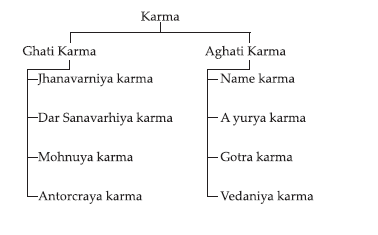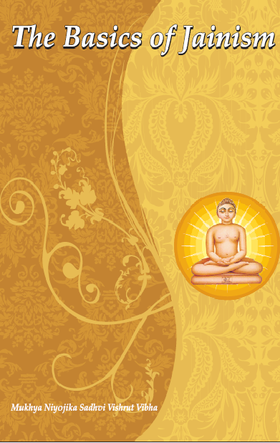There is hardly any person in indian tradition, who is not familiar with the word 'karma'. The doctrine of karma is deeply rooted and is believed by most in the indian religion. The success and failure in one's life depends upon one's karma. A person who leads a luxurious life is believed due to previous favourable karmas. On the contrary, someone leading a miserable life, considers it to be the result of their inauspicious karmas acquired in the past. All the theistic philosophers of India endorse the theory of karma.
The Soul is a conscious and invisible element. While in the worldly state it is covered by subtle layers of karmas. According to Jain philosophy karmas are material. The constant activity of the mind, speech and body, which is called yoga in Jainism, is the main cause of attraction for karmic particles and they attach to the soul. The bondage of karma with the soul is a continuous process. It has been in action since time eternal. The mithyatva (perverted belief), avrata (non restraint), pramada (remissness), kasaya (passions) and yoga (activity) are the main causes of influx of karmic matter into the soul. Karmic matter is extremely subtle. One cannot see or feel it through the eyes or other senses, not even through any kind of microscope or other devices. Only the person who has of extra sensory perception can perceive and realize it.
Division of karma
According to the Jain doctrine of karma, the karmas are of two types:
- Ghati Karma
The karmas which obscure the fundamental nature of the soul are called ghati karma. Ghati karmas are of four types-
- Gyanavarniya karma (knowledge-covering)
The Soul in its abstract state has unlimited knowledge. But it is covered by the dust of the karma particles. The karmas which veil our knowledge are called knowledge-obscuring karmas (gyanavaraniya karma). When our eyes are covered with a strip of cloth, the world around us cannot be seen. In the same way gyanavarniya karmas veil our capacity to attain knowledge.
- Darsanavarniya karma (intuition-covering)
The Soul also has infinite power of intuition. But it is also covered by the dust of karmas. The karma which covers our intuition is called intuition obscuring karma (darsanavarniya karma). It is just like a gate-keeper or a watchman. For example, as the gate-keeper prohibits the entry of every visitor to the residence of a dignitary, similarly darsanavarniya karma obstructs our powers of intuition.
- Mohaniya karma (deluding)
Deluding karma (mohaniya karma) deludes the soul by distorting its faculty of enlightened faith and conduct. Mohaniya karma is intoxicating. As a drunk person loses his control over the conscious mind, similarly, mohaniya karma distorts the faith and conduct of a person and they get perverted.
- Antaraya karma (obstructing)
Antaraya karma (obstructing karma) causes obstruction to the manifestation of the inherent spiritual powers. It is compared with a treasurer who does not allow a person to acquire a required article from the treasury, even though the king has permitted him to take. In the same way, unless antaraya karma is subjugated, one cannot gain the power to access the possession of any object.
- Aghati Karma
The karmas which are responsible for the existence of the soul in a worldly form are called aghati karmas. They are divided into four sub-types-
- Nama karma (body-making)
The nama karma (body-determining karma) is the cause of attainment of different bodily forms in the four realms of existence (viz. hellish, animal, human, celestial). As a painter makes new pictures, in the same way due to nama karma, different kinds of bodies and their structure and feature manifests.
- Ayusya karma (life-span-determining)
Ayusya karma (life-span-determining karma) determines longevity. It can be compared to shackles. As a man fettered with shackles is not able to free himself without breaking them open, in the same way, without enjoying the fruits of ayusya karma a man cannot transmigrate from one life to another, and in the same way without annihilating ayusya karma, one cannot attain salvation.
- Gotra karma (status determining)
On account of the gotra karma (rank-determining karma) one happens to possess high or low status in society. As a potter makes different types of big and small pots, in the same way the gotra karma, causes one to have a high or low status.
- Vedaniya karma (feeling-producing).
The feeling-determining karma (vedaniya karma) is the cause of feelings like pleasure and sufferings. It is just like a sword with its sharp edges smeared with honey. If one licks the sword, he will be delighted with the taste of the honey for a moment but at the same time feels the cut of his tongue. The joyful experience of honey's sweetness is compared as satavedaniya karma, but the cut in the tongue leads to a painful experience which is like the asatavedaniya karma.
Cause of Individual Differences
According to Jain philosophy, karma plays an important role in the creation of personal identities. It is because of the karmas that each individual is different. A person with loads of caliber, having the potential and abilities, sometimes remains unrecognized whereas someone less talented and deserving enjoys all the limelight. All those problems result from a single root cause: karma. One may be tall or short, healthy or unhealthy, may be born in a higher caste or lower caste. All these differences are due to the realisation of karmas.
Relation of Soul and Karma
The relationship between karmas and the soul dates back to eternity. No worldly soul is devoid of karmas. A particular karma which exists with the soul remains for a limited period. None of the karmas can exist with the soul forever. Thus we can conclude that the relationship between karma and the soul is since time immemorial, but that of individual karmas can be said to have a beginning and an end in terms of their attachment to the soul. The relation of karmic matter with the soul should not be deemed impossible on the ground of the formless nature of the self. Though the self is a physical body by itself, its relation with karmic matter is an inherent fact which has no beginning in relation to time. This relation makes the self subject to morphological determination.
Karma is material, while the soul possesses metaphysical qualities and is formless. A mutual relationship between the two develops when the soul gets covered by layers of karmic matter and attains a physical entity. The worldly soul enveloped with karmas attracts new karmas. This vicious cycle only ends when the soul attains moksha by

